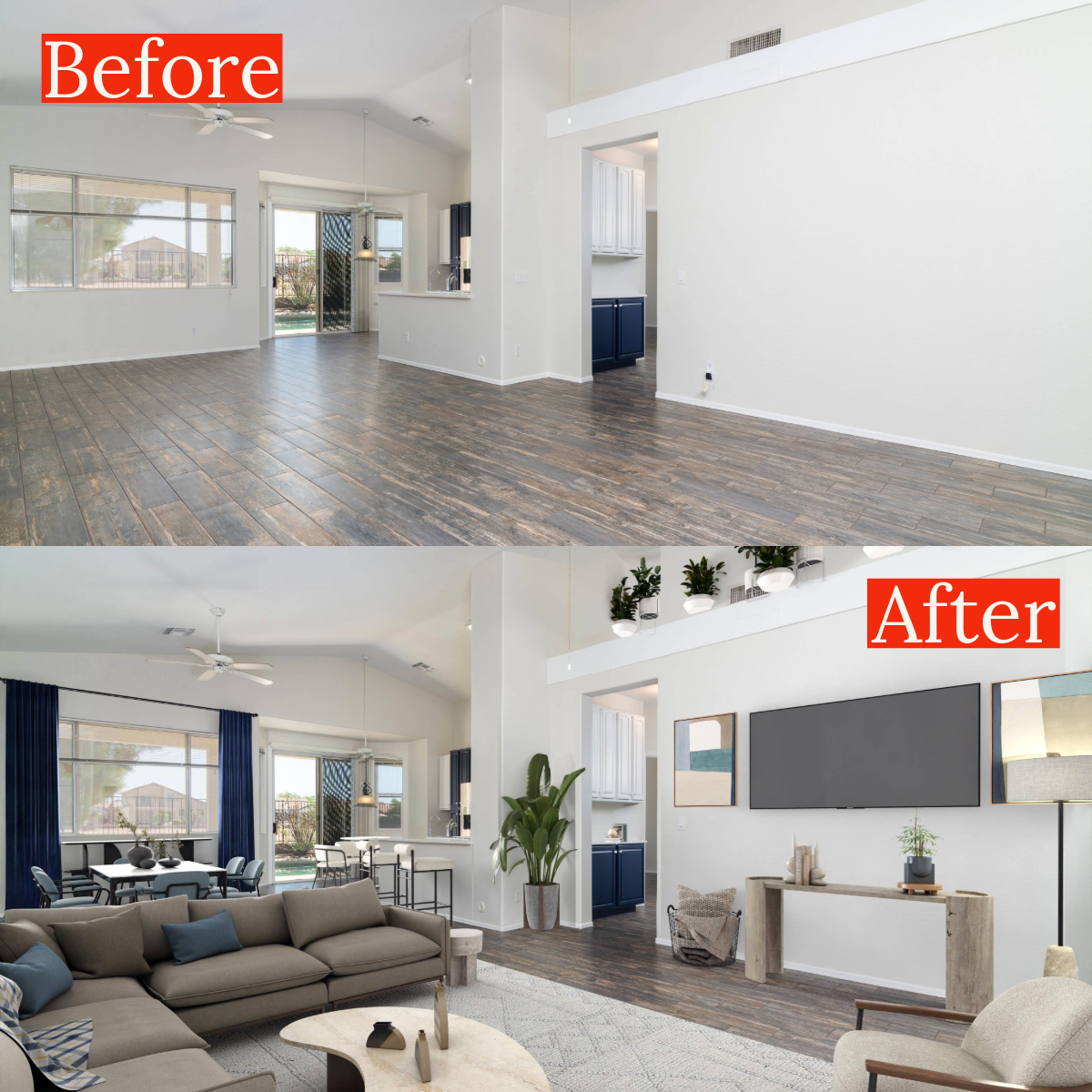By Sean Colón
In Arizona’s fast-paced housing market, first impressions are everything. With nearly 97% of homebuyers starting their search online (per the National Association of Realtors), the way a property appears in photos can make or break a sale. That’s where virtual staging comes in. Beyond aesthetics, digitally furnishing a home taps into buyer psychology, helping them visualize a lifestyle — a critical factor in whether they decide to tour the home or scroll past it.
Why Virtual Staging Works in the Arizona Market
Arizona real estate is unique. From luxury homes in Scottsdale to starter properties in Mesa, buyers are not just looking for square footage — they’re looking for lifestyle. A blank, empty room doesn’t convey much, but a virtually staged space creates an emotional hook.
Psychologically, here’s why it works:
Visualization drives decision-making – Buyers struggle to picture themselves in an empty home. Staged rooms help them “see” their future.
Lifestyle cues boost perceived value – A virtually staged modern kitchen in Gilbert isn’t just about counters and cabinets — it signals entertaining, family, and comfort.
Reduced cognitive load – Empty rooms leave too many questions. Virtual staging narrows the focus, helping buyers process information faster.
In fact, a study by the Real Estate Staging Association found that 85% of staged homes sold for 5–23% over list price, and virtual staging achieves similar results at a fraction of the cost.
The Online-First Buyer Experience
With Arizona’s strong in-migration — more than 77,000 new residents moved to Maricopa County in 2023 alone — many buyers are browsing listings remotely. Virtual staging plays directly into this shift. When photos are the first and sometimes only impression, digitally furnished rooms give out-of-state buyers a clear sense of space and scale, increasing the chance of an in-person showing.
Phoenix and Scottsdale buyers are often relocating professionals. Virtual staging that emphasizes home office setups can resonate strongly.
East Valley families (Mesa, Gilbert, Chandler) respond well to staged children’s rooms, open family areas, and functional layouts.
Luxury buyers in Paradise Valley want aspirational living spaces, from spa-like bathrooms to outdoor entertaining patios.
Cost-Effective and Flexible for Realtors
Unlike traditional staging, which can cost thousands and require logistics, virtual staging is fast, affordable, and customizable. For realtors balancing multiple listings, that flexibility is a game changer.
Consider the advantages:
Lower cost per listing – Traditional staging averages $2,000–$5,000 per home. Virtual staging often costs under $50 per room.
Faster turnaround – Photos can be staged in 24–48 hours, perfect for the rapid pace of the Phoenix housing market.
Style variety – From contemporary downtown condos to Tuscan-style Scottsdale homes, digital staging can be tailored to fit the architecture and buyer demographic.
Tips for Arizona Realtors Using Virtual Staging
To maximize results, here’s how to position virtual staging as part of your listing strategy:
Highlight versatility – Show the same space with two different designs (e.g., home office vs. guest bedroom).
Disclose honestly – Transparency is key. Mention in the listing that the images are virtually staged while still highlighting the home’s potential.
Pair with professional real estate photography – Virtual staging only works if the base photos are high quality. Crisp, well-lit shots of Phoenix and East Valley homes make staging seamless.
Target lifestyle trends – Stage kitchens for entertaining, living rooms for open-concept flow, and outdoor areas for Arizona’s year-round sunshine.
For realtors looking to enhance their marketing toolkit, virtual staging paired with professional architectural photography is one of the most effective ways to increase clicks, showings, and offers.
Why This Matters for Lead Generation
Arizona’s housing market is competitive, and the way your listings look online directly impacts how many leads you generate. Virtually staged photos stop buyers mid-scroll and keep them engaged longer, which leads to:
More clicks from Zillow, Redfin, and Realtor.com listings
Higher engagement on social media ads
More qualified buyers requesting showings
As Phoenix REALTORS® reported in 2024, homes with elevated visuals receive 2–3x more online views than unstaged, unedited listings. That’s not just more attention — it’s more opportunities to close.
Final Thoughts
For Arizona realtors, virtual staging isn’t just a design trend — it’s a psychology-backed strategy that moves homes faster and at higher price points. In a market where buyers are making decisions online first, showcasing a lifestyle through digitally furnished rooms could be the competitive edge your listings need.
If you’re looking to integrate virtual staging and professional real estate photography in Phoenix, Scottsdale, or the East Valley, now is the time to make it part of your marketing strategy.
By the way, I help realtors improve their online and social media presence by providing beautiful photos of their listings. That is why I’ve created this FREE HOME PREP LIST for your clients to help your listings look their best. Feel free to share.




